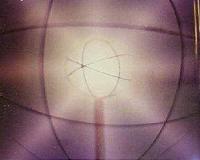 |
Warwick UK (SPX) Jan 11, 2011 Researchers at the University of Warwick's Centre for Fusion Space and Astrophysics and the UK Atomic Energy Authority's Culham Centre for Fusion Energy may have found a way to channel the flux and fury of a nuclear fusion plasma into a means to help sustain the electric current needed to contain that very same fusion plasma. The researchers used large scale computer simulations to confirm a longstanding prediction by US researchers that high energy alpha particles born in fusion reactions will be key to generating fusion power in the next planned generation of tokamaks. The Warwick and Culham researchers were modelling the interaction of particular types of waves with alpha particles in a fusion plasma when they found that an expected type of wave was forming naturally within the plasma and that it was quickly growing in strength. As the simulation progressed the wave began to transfer energy from alpha particles to make an electric current which could help confine the plasma. This particular type of waves, LH (lower hybrid) waves, are in fact often used by fusion researchers to generate the electric current required to confine and control the plasma - but these waves are usually generated externally to the plasma and channelled into it to create the current. The Warwick researchers' model suggests that in fact these waves will occur naturally in the plasmas of fusion reactors and in doing so may be able to help exploit the energy of alpha particles. This would open up far more efficient methods of creating and sustaining the current needed to confine the plasma and could provide a mechanism that would confirm earlier predictions by US researchers, that the energy of Alpha particles would be key to the development of fusion energy. This work was only possible using the recently commissioned large scale computing facilities at the University of Warwick supported by EPSRC, in particular for theoretical work supporting fusion energy generation. University of Warwick researcher Professor Sandra Chapman said: "These large scale computer simulations capture the plasma dynamics in unprecedented detail and have opened up an exciting new area." The research paper entitled : Electron Current Drive by Fusion-Product-Excited Lower Hybrid Drift Instability has just been published in Physical Review Letters and is by J. W. S. Cook and Professor Sandra Chapman at the Centre for Fusion Space and Astrophysics, Department of Physics, Warwick University, Coventry CV4 7AL, United Kingdom; and Professor R. O. Dendy of Euratom/CCFE Fusion Association, Culham Science Centre, Abingdon, Oxfordshire. This work is part of a significant initiative funded by the EPSRC (The Engineering and Physical Sciences Research Council) to support the science underpinning fusion energy in the UK.
Share This Article With Planet Earth
Related Links Centre for Fusion, Space and Astrophysics Powering The World in the 21st Century at Energy-Daily.com
 From 'Star In A Jar' To Spaceflight, One Experimenter Has High Hopes For Fusion
From 'Star In A Jar' To Spaceflight, One Experimenter Has High Hopes For FusionMelbourne FL (SPX) Jan 10, 2011 Dr. Robert Goddard, the inventor of the liquid-fuel rocket engine, conducted most of his pioneering work alone and with a close-knit group of technicians. Working alone, he was derided by scientists and ridiculed by the media during the early pioneering years who claimed that a rocket couldn't fly in outer space without an atmosphere for its engine to "push" against. At one point, Goddard ... read more |
|
| The content herein, unless otherwise known to be public domain, are Copyright 1995-2010 - SpaceDaily. AFP and UPI Wire Stories are copyright Agence France-Presse and United Press International. ESA Portal Reports are copyright European Space Agency. All NASA sourced material is public domain. Additional copyrights may apply in whole or part to other bona fide parties. Advertising does not imply endorsement,agreement or approval of any opinions, statements or information provided by SpaceDaily on any Web page published or hosted by SpaceDaily. Privacy Statement |